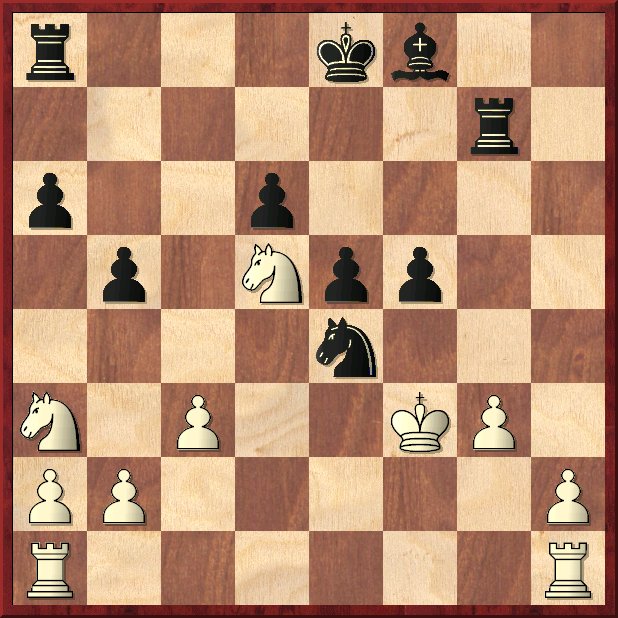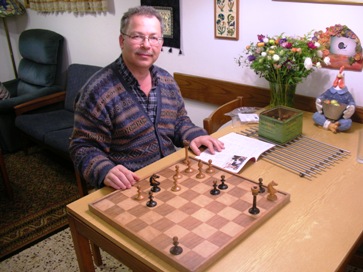The
Liechtenstein Museum Match
Roland Stratmann is an
artist affiliated with the Kunstmuseum in Liechtenstein.
He has developed several projects celebrating games in art,
and proposed a chess
match with an Israeli and Arab team playing an American and
a Cuban team,
sponsored by ICCF. Since I had played in the tournament
honoring 30 years
of the Cuban Correspondence Chess organization, I was
selected to play
with SIM Pablo Salcedo Mederos as my teammate. Our
opponents were
GM Yoav Dothan (Israel) and SIM Khalid Chorfi (Morocco).
The format was for
one move to be made per day, Tuesday through Saturday, with
the players
alternating turns making moves. This is a fast time control
for correspondence chess,
but the quality of the moves was still good.
The game was displayed
in the lobby of the Kunstmuseum, on a board on the ceiling
(each square about one meter on a side), with banners
hanging down for the pieces.
The lobby also serves as a restaurant, so there was chess on
display with lunch and dinner.
By coincidence my wife and I were invited to the wedding of
our 1990 foreign exchange
student in Paris in late May, shortly before the match was
to begin. So we flew to
Zurich and took a one hour train ride to Sargans,
Switzerland. The museum staff
was very welcoming, including a brief car ride to the
Kunstmuseum. It is a new
museum of modern art, and we were given a tour of the museum
by Roland Stratmann
and curator Nike Baetzner. Our hosts made the visit
delightful, a good start on our
trip to Paris for the wedding.
Pablo played odd
numbered moves, and selected the Sicilian Defense,
1.e4 c5… I have met this with white pieces, but never
played it as black.
And I always play Bb5 lines, so this was an adventure for
me!
Yoav
Dothan, Khalid Chorfi (2591)
Schakel, Pablo Salcedo (2386)
[B33], Liechtenstein Museum Match,
17.09.2005
1.e4 c5 2.Nf3 Nc6 3.d4 cxd4
4.Nxd4 Nf6 5.Nc3 e5 6.Ndb5 d6 7.Bg5 a6
8.Na3 b5 9.Bxf6 gxf6 10.Nd5 f5 11.Bd3 Be6 12.Qh5 Rg8 13.g3 …
White had numerous choices here, but they played what is
considered the sharpest move.
13. …Nd4 …
This is the best of several options for black.
14.c3 fxe4 15.Bxe4 Bg4 16.Qxh7 Rg7 17.Qh6 Nf3+ 18.Ke2 …
Here
18.Kf1 Rg5 19.Nf6+ Ke7 20.Qh8 Nd2+ 21.Kg2 Nxe4 22.Nxg4 Rxg4
23.f3 Nxg3
does not give white much, if any, advantage.
18. … Ng5+ 19.f3 Nxe4
20.fxg4 Qc8 21.Qe3 Qxg4+ 22.Qf3 Qxf3+ 23.Kxf3 f5
…, and this is the end of ECO (B33) analysis,
with the position “unclear.”
But it looks to me like a draw should be reached, although
white is now
defending a somewhat weaker position (black controls the
center, as noted below).

24.Nc2 Kf7 25.Nce3 Nf6
26.a4 Nxd5 27.Nxd5 Ke6 28.Rhd1 Raa7
…, a position also reached in Tommasi-Panicali (Sicilian
Lasker theme tournament, 1999) andKahl-Sakai (Board 1 in
the15th Anniversary Tournament of the Rochade,
Germany ChessClub, 2004). Both games ended in a draw
shortly thereafter.
Black has a space advantage, and control of the center, but
not enough advantage
to counter the threat of white’s h-pawn.

29.b3 Rh7 30.axb5 axb5
31.Rxa7 Rxa7 32.g4 fxg4+ 33.Kxg4 Ra3 …
The possibility of
33. … Be7 is met by
34.Nxe7
…, and pushing the h-pawn.
34.Nc7+ Kd7 35.Nxb5 Rxb3 36.Rf1 Be7 37.c4 Rb4
½–½.
Despite white’s isolated pawns, the
advancing h-pawn forces a draw.
It was a pleasure and an honor to play this
match on the ICCF server, and to
play with Pablo as a teammate. I enjoyed the communications
with Pablo,
as well as Yoav Dothan, Khalid Chorfi, and our TD, Med
Samraoui. This was
a truly memorable summer for me! Corky Schakel, Lakeland,
Minnesota
Later the
Israeli GM Yoav Dothan added :

“First I would like to
thank everyone that organized this special game -
it is a rare experience to play such a game with a partner -
and to play together
a game against two players with the alterating moves.
I used to play in the past OTB games , and then , a variant
with blitz was
played in a similar way , the results sometimes very amusing
, when in a
few seconds you may guess ... or not ... your partner
intentions.
I must confess that we discussed the game only 2-3 times .
If I remember correctly (it is a pity that I cannot see the
E-mails that
I sent via the server - I do not get a copy!) I send to my
partner my humble
collectios of games thatreached the same opening , Had
Iknown that the
analysis goes so deeply in the game , I would probably
deviate much earlier.
In this way we reached a position that almost is drawn ,
without much
chances to complicate the game.
I went again to my notes , and as the pace was "fast"
comparatively
to normal CC games , my analysis is divided to two parts :
first part ,
about 20 moves , is minimal , as we followed the theory.
The second part , till the end , is checking our own moves ,
and some forced moves
like 23. K:f3 where you do not have to spend too many
seconds for the decision...
In some games there are difficult decision : you see a few
moves that lead to
unclear positions , and it is very difficult to assess them
correctly and to
choose the correct plan. In this game , many decions were
easier.
Maybe 26. N:f6 ? but after K:f6 the position seems already a
draw.
I did not contribute much to the analysis , but maybe added
some
insight to our feeling during the game.
For the future : I will be happy to participate in such a
game again ,
but maybe you will consider to organize a number of games -
like every country will be represented by 4 players , and
there will be four
games at the same time ? Maybe more fun to the visitors in
the Liechtenstein Museum .”
Thanks to Roland Stratmann , we can confirm that the motto
“amici sumus”
is wonderful and ICCF is promoting the peace through the
World
and this game is a good example of friendship without
borders .
|